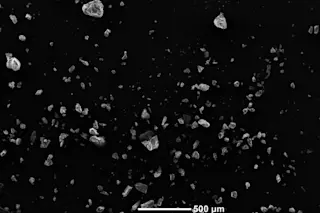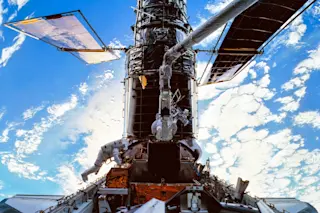So what is it your office does?
Our primary charter is to characterize the near-earth environment – monitoring debris orbiting the Earth.
How do you do that? Can you actually tell where all the debris is?
For things that are larger than 10 centimeters in diameter, the DoD operates the US Space Surveillance Network. They monitor each of them on a day-to-day basis with ground-based radars optical sensors.
For an object smaller than 10 centimeters, it's very hard for a ground-based sensor to keep track of it on a regular basis. With ground-based radars [the Orbital Debris office] can detect objects a couple millimeters in diameter. We can't track them, but we can create statistics, and find how many objects are at various altitudes.
Where does it come from? How much is natural and how much is man-made?
The primary source has been the explosions of spacecraft rocket bodies, and many of these were accidental. The rockets flew successfully, left their payloads successfully, were left in earth orbit, and then – sometimes hours later, sometimes 25 years later – they blew up. It's all man-made; there's nothing natural that orbits the earth but the moon.
How many explosions have there been?
My list has 181 explosions, but includes a few collisions – 3 accidental and 2 intentional ones.
Intentional collisions?
They were in the 1980s – Reagan, the evil empire, and all those things. We were working on an anti-satellite program. It was an Air Force program that entailed firing missile from aircraft and would impact adversaries' spacecraft. We tested it. It was never deployed, and then the program was cancelled – Congress cut the funding. One of those tests was against a U.S. satellite. It worked.
It worked? So the satellite was hit by…
The business end of a missile. Fortunately, the satellite we tested was in a low enough altitude that the stuff came down in a few years.
How much junk is out there?
For things bigger than 10 centimeters, there are about 8,000. Things that are larger than 1cm, we're talking a few hundred thousand. If you're talking things larger 1mm, we're talking a hundred million.
That is a lot of debris. With all of that out there, does it endanger the space shuttle?
It's a very significant portion of the risk to a shuttle. It's the highest risk after launch.
So if this is such a big problem, are there any plans for the future to actively deal with it? If space traffic increases, might we try to actually eliminate orbital debris? I'm basically asking if we will ever vaporize the space junk.
We continue to look at means to remediate the environment, but we have not yet found a technique which is both technically feasible and economically viable.
I know this is a very scientific enterprise, but do you give catchy names to any of the debris?
Debris are given an official international designator and a U.S. satellite number, which is a sequential number dating back to the Sputnik 1 rocket body. On rare occasions, if the nature of the debris is known, a common name will also be assigned – cooler cover.
Could you give me an example? Maybe one of the coolest covers?
A screwdriver was inadvertently lost during the Space Shuttle mission of late August, 1985. It was given an international designator of 1985-076H and a U.S. satellite number of 16013. The common name is "Debris Screwdriver."
Now you're just getting wacky. Do you ever slip up and call the debris "space junk"?
Obviously it's widely used term, but no, we normally don't do that. When other people use it we know what they're talking about. We don't take it personal.














